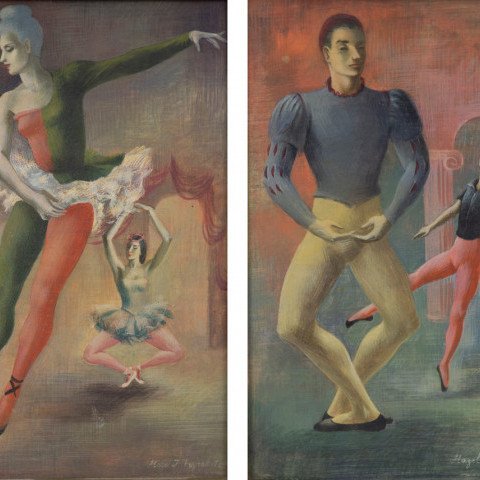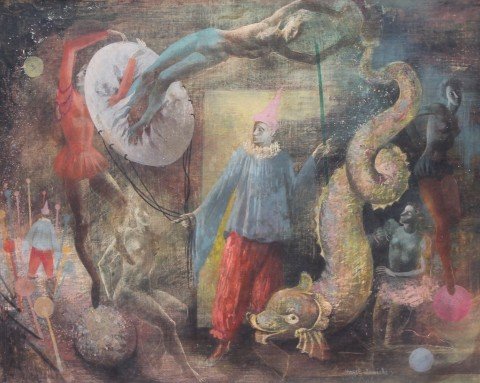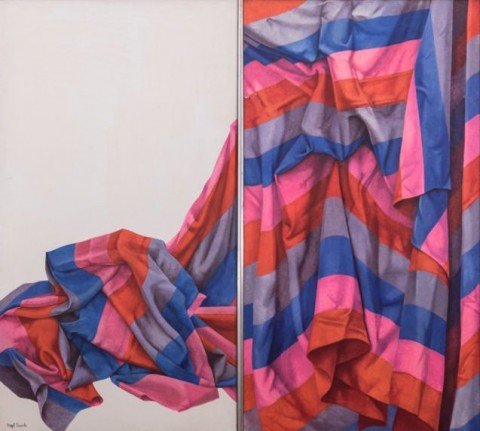Hazel Middleton was born on February 19, 1918 in London, England to American parents, Joseph and Madeline Faulkner Janicki, where her father worked for the United States State Department. Her family was soon transferred to Paris where they lived for many years. After her father's death in 1925, Hazel's mother married Joseph Janicki and Hazel adopted the Janicki name. In 1928 the family moved to Cleveland, Ohio. Hazel graduated from Lakewood High School and enrolled in the Cleveland School of Art where she studied with muralist Kindred McLeary. Due to an allergy to turpentine, she began painting in tempera, a medium she continued to use throughout her career. She worked for Cleveland Public Library making posters and displays. In the 1944 Artists for Victory exhibition at Metropolitan Museum of Art, Janicki’s mural for the USO Lounge in Cleveland’s Old Federal Bldg. received honorable mention. Janicki was an accomplished portraitist, but was best-known for her tempera paintings of realistic figures in dreamlike settings.
In 1941 Hazel was awarded a grant for post graduate work and traveled to Washington, D.C. and Philadelphia to study murals in public buildings. At that time she began exhibiting in the Cleveland Museum of Art May Shows and other local exhibitions. In 1942 Hazel married John Teyral, a painter and instructor at the Cleveland School of Art. During the war years she continued to paint and accepted several commissions for murals in the Cleveland area.
Hazel received a Tiffany Foundation Award for painting in 1949 and in 1951 signed with the Durlacher Brothers Gallery in New York City where she continued to exhibit until 1968 when the gallery closed. She then became affiliated with the Fairweather Hardin Gallery of Chicago. She received a University of Illinois prize (1948) and a grant from the National Institute of Arts & Letters (1955).
Divorced some years earlier, Hazel married William Schock in 1951 and moved to Kent, Ohio. She began teaching design, drawing and painting at Kent State University and continued there as a part-time and full-time instructor until her death. In 1952 Hazel and Bill traveled in the American southwest, an experience which inspired a large body of work. In 1955, she was awarded the Clarke Prize for Painting from the National Academy of Design. Hazel's work in the 1960s demonstrated a growing interest in drawn, painted and sculptural constructions. Janicki combined abstraction with detailed studies of rocks, shells, nests, drawers, and draperies into the 1960s, with actual draperies and other objects beginning to emerge from her paintings, and tromp de l’oeil renderings covering wooden constructions (Children’s Room Door, 1969, Akron Public Library). In the 1970s she returned to painting (“Triptych: Heaped, Stretched, Hanging,” 1972, Kent State University).
Hazel Janicki was a frequent award winner in local and regional competitions and also had her paintings and drawings exhibited internationally, and was active with Ten Thirty Gallery, and was president of the Women’s Art Club. Her works can be found in the permanent collections of the Cleveland Museum of Art, the Art Institute of Chicago, Detroit, Akron, Canton, and Melbourne, Australia, the Butler Institute of American Art, the Yale Museum of Art, as well as other public and private collections.
Hazel Janicki, along with her husband William Schock and her stepfather were fatally injured in an automobile accident in Florida on New Year's Day, 1976. Both Janicki and Schock were recognized as being among the finest contemporary artists from the Ohio and the Midwest area.
Works by Hazel Janicki

Ballet Dancers, 1945 Hazel Janicki

SOLD
Nature Walk, 1960 Hazel Janicki

SOLD
Nocturne, 1945 Hazel Janicki

SOLD
Ballet Mirage, 1945 Hazel Janicki

SOLD
Theater, 1945 Hazel Janicki

SOLD
Masquerade, 1945 Hazel Janicki

SOLD
The Clown’s Dream, 1947 Hazel Janicki

SOLD
Heaped and Hanging, Diptych, 1973 Hazel Janicki
